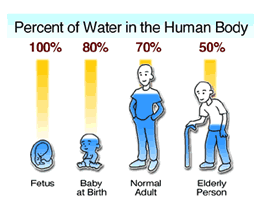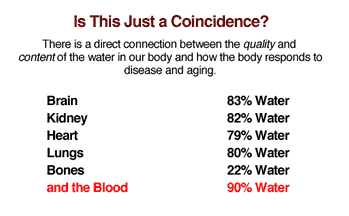| ||
Fluid fluctuations affect blood volume and intracellular hydration levels. This can be life threatening. When the amount of fluid within various cellular compartments is relatively constant, there is an exchange of solutes and water between compartments to maintain unique compositions. Individuals with more body fat have proportionately less total body water and are more susceptible to fluid imbalances that cause dehydration.
The body must continuously be in a proper state of hydration. Because three liters of water is lost each day through normal bodily functions, this must be replaced. There are two major issues that emphasize the need to keep the body adequately hydrated with water of the best quality, content, and structure so it can maintain homeostasis. First, the water we put in our body must be able to prevent acidic toxins and chemical substances from accumulating and creating destructive influences on cells. Water must bring all minerals and nutrients required for cell metabolism, and remove any acidic substances that can damage the cell. It must also be able to protect cell walls from damage and invasion. Second, since water is involved in every function of the body, it must act as a conductor of electrochemical activity, such as neurotransmission, by moving water from one nerve cell to another smoothly and effectively. Movement of water in the body between cells (extracellular fluid) is caused by osmosis. This is created by magnetic forces in the body, which keep the movement in balance. As water flows, changes in pressure create movement across the cell membranes. Any changes in pressure will allow proteins, minerals and other nutrients being carried by the blood to escape into spaces between vessels and deprive the cells of their vital needs to sustain life. When the alkaline water in the blood is contaminated with acidic chemicals, it enters the cells and changes their structure, which in turn can lead to changes in DNA (pleomorphism). This is the start of the dis-ease process, which is very similar to the aging process. | ||
Results found at > Home > The Human Body is a Body of Water
Sunday, February 19, 2012
The Human Body is a Body of Water
Subscribe to:
Post Comments (Atom)



 Total body water percentage decreases with age, resulting in inadequate cellular hydration. Most critical is the decrease in the ratio of intracellular hydration. The normal ratio is 60% intracellular, 40% extracellular. The reason for change in this ratio is due in part to an increase in fat along with a decrease in muscle, and a decreased ability of the body to regulate sodium and water balance. With age, kidney function becomes less efficient in producing urine, and responses for conserving sodium weaken.
Total body water percentage decreases with age, resulting in inadequate cellular hydration. Most critical is the decrease in the ratio of intracellular hydration. The normal ratio is 60% intracellular, 40% extracellular. The reason for change in this ratio is due in part to an increase in fat along with a decrease in muscle, and a decreased ability of the body to regulate sodium and water balance. With age, kidney function becomes less efficient in producing urine, and responses for conserving sodium weaken.
No comments:
Post a Comment